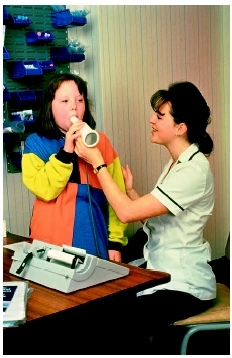Pulmonary function tests
Definition
Pulmonary function tests are a group of procedures that measure how well the lungs are functioning.
Purpose
Pulmonary function tests help a doctor to diagnose respiratory diseases and disorders such as asthma , chronic obstructive pulmonary disease (COPD), and emphysema, and mechanical injury by measuring the degree of lung impairment. These tests are also done before major lung surgery to make sure the patient will not be disabled by having a reduced lung capacity. When performed over time, these tests are helpful in evaluating how a lung disease is progressing, and how serious the lung disease has become. They are also be used to assess how a patient is responding to different treatments.
Description
There are many types of pulmonary function tests. The most common are:
- peak expiratory flow rate (PEFR) measures airflow during forced expirations
- forced vital capacity (FVC) measures the maximum amount of air exhaled after taking a deep breath
- forced expiratory volume in one second (FEV1) measures the amount of air that can be exhaled in one second
- maximum voluntary volume (MVV) measures the amount of air a person can breathe in and out in one minute
- total lung capacity (TLC) is the measure of the amount of air the lungs can hold
-
residual volume (RV) is the amount of air left in the lungs after forced
expiration
 A cystic fibrosis patient receives a pulmonary function test.(Custom Medical Stock Photo Inc.)
A cystic fibrosis patient receives a pulmonary function test.(Custom Medical Stock Photo Inc.) - arterial blood gas (ABG) measures the amount of oxygen and carbon dioxide in the blood and gives a picture of how efficiently the lungs are functioning
- pulse oximetry measures the percentage of oxygen in the blood
With the exception of arterial blood gas, pulse oximetry, and total lung capacity, pulmonary function tests are performed using spirometry (from the Greco-Latin term meaning "to measure breathing"). Spirometry tests can be done a hospital or doctor's office. The patient places a clip over the nose and breathes through the mouth into a tube connected to a machine called a spirometer. The patient breathes in deeply, and then exhales as quickly and forcefully as possible into the tube. The machine records the volume of air that moves through the tube. The exhalation must last at least six seconds for the machine to work properly. Usually the patient repeats this test three times, and the best of the three results is considered the measure of the lung function. A similar machine called a peak flow meter may be used to measure PERF. Sometimes when airways are obstructed, the patient is given a bronchodilator, and the test is performed again.
Total lung capacity is measured by body plethysmography. The patient sits in a sealed box that resembles a telephone booth and breathes against a mouthpiece. A device measures the changes in air pressure in the box during inhalation and exhalation. From these air pressure measurements, the total capacity of the lungs can be calculated.
Arterial blood gases are measured on a blood sample that is taken from an artery. Pulse oximetry uses a sensor placed on the earlobe or fingertip to measure the amount of oxygen in the blood.
Taken together, pulmonary function tests give a good picture of how much air is moving in and out of the lungs and how efficiently oxygen is moved into the blood and carbon dioxide is moved out. Some of these tests are performed as part of a routine health screening, while others are used most often to evaluate the condition of diseased or damaged lungs.
Precautions
Except for the arterial blood gas tests and pulse oximetry, pulmonary function tests should not be given to patients who have had a recent heart attack, or who have certain other types of heart disease. Conditions that cause pain on breathing, such as broken ribs, may interfere with the performance of the tests and produce inaccurate results. Children must be old enough to follow directions and inhale and exhale as instructed.
Preparation
The patient should not eat a heavy meal before the test, nor smoke for four to six hours beforehand. The doctor will give specific instructions about whether or not to use medications before the test.
Aftercare
No special aftercare is needed following these tests.
Risks
Risks with these tests are minimal. However, some people become lightheaded or faint. The tests may also trigger an asthma attack in individuals with asthma.
Parental concerns
Normal results are based on a person's age, height, and gender. Normal results are expressed as a percentage of the predicted lung capacity. Results of 80 percent or less suggest some sort of lung impairment.
KEY TERMS
Artery —A blood vessel that carries blood away from the heart to the cells, tissues, and organs of the body.
Bronchodilator —A drug that when inhaled helps to expand the airways.
Carbon dioxide —A heavy, colorless gas that dissolves in water.
Forced exhalation —Blowing as much air out of the lungs as possible.
Resources
BOOKS
Pulmonary Function Testing and Cardiopulmonary Stress Testing. Delmar Publishing, 1997.
Ruppel, Gregg L. Manual of Pulmonary Function Testing. St. Louis: Mosby, 1997.
WEB SITES
Blaivas, Allen J." Pulmonary Function Tests." MedlinePlus Encyclopedia. 27 January 2004. http://www.nim.nih.gov/medlineplus/ency/article/003853.htm.
HealthGuide A-Z "Lung Function Tests" WebMD.com 5 May 2003. http://my.webmd.com/hw/health_guide_atoz/hw5022.asp?lastselectedguid+{5FE84E90-BC77-4056-A91C-9}.
Tish Davidson, A.M. Carol A. Turkington
Comment about this article, ask questions, or add new information about this topic: